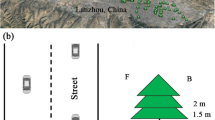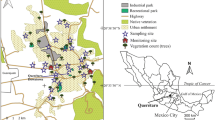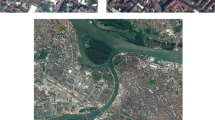Abstract
Atmospheric deposition particles are fine-sized having a high adsorption capacity. Therefore, they can easily transfer the contamination to other areas. Plants can absorb certain pollutants using their leaves and then accumulate them in their biomass. In this study, the spatial and temporal variability of air pollution was assessed using pine needles as the bioindicators of atmospheric pollution. The magnetic susceptibility (MS) at low and high frequencies (χlf, χhf) and the concentration of selected heavy metals of pine needles (Pinus mugo) were estimated in order to address the possible relationships between needles’ MS and the heavy metal concentration in the city of Isfahan, central Iran. In addition, the relationship between the heavy metal concentration of pine needles and that of the atmospheric dust was examined using the published data. Tree pine needles were monthly sampled, from April to December 2015 (T1–T9), during 9 months, from 30 different sites in the Isfahan city. There were two treatments including washed + unwashed (WU) and washed + washed (WW). The heavy metal total concentrations including Zn, Fe, Cu, Co, Pb, and Ni were measured. The mean concentrations of Fe, Zn, Pb, Cu, Ni, and Co were 80.4, 3.9, 1.8, 1.4, 0.6, and 0.3 mg kg−1, respectively. The results revealed that the concentration of heavy metals and MS in the pine needles followed the order Fe > Zn > Pb > Cu > Ni > Co. Also, the heavy metal concentration in the pine needles with different treatments had the following trend: WU > WW. It was shown that there was a significant correlation (p < 0.01) between the heavy metal concentrations and the leaf MS values of the pine needles and the concentration of heavy metals in atmospheric dust. Besides, similar trends were detected for the spatial variability of heavy metals and the pine needles’ MS. In general, it could be concluded that the biomagnetic approach could serve as a comparatively fast and low-cost method to detect highly polluted urban areas with selected heavy metals, particularly the areas which are under the influence of anthropogenic and other traffic-related sources.





Similar content being viewed by others
References
Alfani A, Baldantoni D, Maisto G, Bartoli G, Virzo De Santo A (2000) Temporal and spatial variation in C, N, S, and trace element contents in the leaves of Quercus ilex within the urban area of Naples. Environ Pollut 109:119–129
Allahabadi A, Ehrampoush MH, Miri M, Aval HE, Yousefzadeh S, Ghaffari HR, Ahmadi E, Talebi P, Fahabadi ZA, Babai F (2017) A comparative study on capability of different tree species in accumulating heavy metals from soil and ambient air. Chemosphere 172:459–467
Anicic M, Spasic T, Tomasevic M, Rajsic S, Tasic M (2011) Trace elements accumulation and temporal trends in leaves of urban deciduous trees (Aesculus hippocastanum and Tilia sp). Ecol Indic 11:824–830
Arruti A, Fernández-Olmo I, Irabien Á (2010) Evaluation of the contribution of local sources to trace metals levels in urban PM2. 5 and PM10 in the Cantabria region (Northern Spain). J Environ Monitor 12:1451–1458
Ayoubi S, Abazari P, Zeraatpisheh M (2018) Soil great groups discrimination using magnetic susceptibility technique in a semi-arid region, central Iran. Arab J Geosci 11(20):616. https://doi.org/10.1007/s12517-018-3941-4
Baycu G, Tolunay D, Özden H, Günebakan S (2006) Ecophysiological and seasonal variations in Cd, Pb, Zn, and Ni concentrations in the leaves of urban deciduous trees in Istanbul. Environ Pollut 143:545–554
Bou Kheir R, Greve HM, Abdallah C, Dalgaard T (2010) Spatial soil zinc content distribution from terrain parameters: a GIS-based decision-tree model in Lebanon. Environ Pollut 158(2010):520–528
Burger J (2006) Bioindicators: a review of their use in the environmental literature 1970–2005. Environ Bioindic 1(2):136–144
Celik A, Kartal AA, Akdogan A, Kaska Y (2005) Determining the heavy metal pollution in Denizli (Turkey) by using Robinio pseudo-acacia L. Environ Int 31:105–112
Chaparro MAE, Lavornia JM, Chaparro MAE, Sinito AM (2013) Biomonitors of urban air pollution: magnetic studies and SEM observations of corticolous foliose and microfoliose lichens and their suitability for magnetic monitoring. Environ Pollut 172:61–69
Christoforidis A, Stamatis N (2009) Heavy metal contamination in street dust and roadside soil along the major national road in Kavala’s region, Greece. Geoderma. 151:263–275
Dankoub Z, Ayoubi S, Khademi H, Lu S-G (2012) Spatial distribution of magnetic properties and selected heavy metals in calcareous soils as affected by land use in the Isfahan region, Central Iran. Pedosphere 22(1):33–47
Davila AF, Rey D, Mohamed K, Rubio B, Guerra (2006) Mapping the source of urban dust in the coastal environment by measuring magnetic parameters of Platanus hispanica leaves. Environ Sci Technol 40:3922–3928
De Nicola F, Maisto GM, Prati V, Alfani A (2008) Leaf accumulation of trace elements and polycyclic aromatic hydrocarbons (PAHs) in Quercus ilex L. Environ Pollut 153:376–383
Dearing J (1999) Magnetic susceptibility. In: Walden J, Oldfield F, Smith JP (eds) Environmental magnetism: a practical guide. Technical Guide No. 6. Quaternary Research Association, Cambridge, pp 35–62
Dearing JA, Dann RJL, Hay K, Lees JA, Loveland PJ, Maher BA, O'Grady K (1996) Frequency-dependent susceptibility measurements of environmental materials. Geophys J Int 124:228–240
Dogan Y, Ugulu I, Basler S (2010) Turkish red pine as a biomonitor: a comparative study of the accumulation of trace elements in the needles and bark. Ecology. 19(75):88–96
Evans ME, Heller F (2003) Environmental magnetism: Princ. Appli. Enviro. International Geophysics Series, Vol. 86. Academic Press, Elsevier, London, pp 299
Faiz Y, Tufail M, Javed MT, Chaudhry M, Siddique N (2009) Road dust pollution of Cd, Cu, Ni, Pb and Zn along Islamabad Expressway, Pakistan. Microchem J 92:186–192
Feizi Z, Ayoubi S, Mosaddeghi MR, Besalatpour AA, Zeraatpisheh M, Rodrigo-Comino J (2019) A wind tunnel experiment to investigate the effect of polyvinyl acetate, biochar, and bentonite on wind erosion control. Arch Agron Soil Sci 65:1049–1062
Ferner DJ (2001) Toxicity, heavy metals. eMed J 2(5):1
Fosmire GJ (1990) Zinc Toxicity. Am J Clin Nutr 51(2):225–227
Fourati R, Scopa A, Ben Ahmed C, Ben Abdallah F, Terzano R, Gattullo CE, Allegretta I, Galgano F, Caruso MC, Sofo A (2017) Leaf biochemical responses and fruit oil quality parameters in olive plants subjected to airborne metal pollution. Chemo J Environ 168:514–522
Freitas H, Prasad MNV, Pratas J (2004) Analysis of serpent pinophytes from north-east of Portugal for trace metal accumulation-relevance to the management of mine environment. Chemosphere. 54:1625–1642
Fujiwara FG, Gomez DR, Dawidowski L, Perelman P, Faggi A (2011) Metals associated with airborne particulate matter in road dust and tree bark collected in a megacity (Buenos Aires, Argentina). Ecol Indic 11:240–247
Gautam P, Blaha U, Appel E (2005) Magnetic susceptibility of dust-loaded leaves as a proxy of traffic-related heavy metal pollution in Kathmandu city, Nepal. Atmos Environ 39:2201–2211
Goluchowska BJ (2001) Some factors affecting an increase in magnetic susceptibility of cement dusts. J Appl Geophys 48:103–112
Gueguen F, Stille P, Geagea ML, Boutin R (2012) Atmospheric pollution in an urban environment by tree bark biomonitoring—part I: trace element analysis. Chemosphere 86:1013–1019
Hansard R, Maher BA, Kinnersley R (2011) Biomagnetic monitoring of industry derived particulate pollution. Environ Pollut 159(6):1673–1681
Hassan IA, Basahi J (2013) Assessing roadside conditions and vehicular emissions using roadside lettuce plants. Pol J Environ Stud 22(2):387–393
Hay KL, Dearing JA, Baban SMJ, Loveland PJ (1997) A preliminary attempt to identify atmospherically-derived pollution particles in English topsoils from magnetic susceptibility measurements. Phys Chem Earth 22:207–210
Holum JR (1983) Elements of general and biological chemistry, 6th edn. John Wiley and Sons, New York, p 324, 326, 353, 469
Isfahan Governor’s office (2013) Isfahan Province Statistical Year Book of 2012, p 881
Kalinovic TS, Serbula A, Radojevic J, Kalinovic M, Steharnik J, Petrovic (2016) Elder, linden and pine biomonitoring ability of pollution emitted from the copper smelter and the tailings ponds. Geoderma. 262:266–275
Kardel F, Wuyts K, Maher BA, Hansard R, Samson R (2011) Leaf saturation isothermal remanent magnetization (SIRM) as a proxy for particulate matter monitoring: inter-species differences and in season variation. Atmos Environ 45:5164–5171
Karimi R, Ayoubi S, Jalalian A, Sheikh-Hosseini AR, Afyuni M (2011) Relationships between magnetic susceptibility and heavy metals in urban topsoils in the arid region of Isfahan, central Iran. J Appl Geophys 74(1):1–7
Kaur-Sidhu M, Ravindra K, Mor S, John S, Aggarwal AN (2019) Respiratory health status of rural women exposed to liquefied petroleum gas and solid biomass fuel emissions. Air Soil Water Res 12:1178622119874314
Klose S, Koch J, Baucker E, Makeschin F (2001) Indicative properties of fly-ash affected forest soils in Northeastern Germany. J Soil Sci Plant Nutr 164:561–568
Kocić K, Spasić T, Aničić Urošević M, Tomašević M (2014) Trees as natural barriers against heavy metal pollution and their role in the protection of cultural heritage. J Cult Herit 15:227–233
Lado L, Hengl T, Reuter H (2008) A geostatistical analysis of the FOREGS Geochemical database. Geoderm. 148:189–199
Lehndorff E, Schwark L (2004) Biomonitoring of air quality in the Cologne Conurbation using pine needles as a passive sampler—part II: polycyclic aromatic hydrocarbons (PAH). Atmos Environ 44:2822–2829
Liu X, Ouyang W, Shu Y, Tian Y, Feng Y, Zhang T, Chen W (2019) Incorporating bioaccessibility into health risk assessment of heavy metals in particulate matter originated from different sources of atmospheric pollution. Environ Pollut 254:113113
Lu SG, Bai SG (2006) Study on the correlation of magnetic properties and heavy metals content in urban soils of Hangzhou City, China. Geophys J Int 60:60–12
Lu SG, Bai SQ, Cai JB, Xu C (2005) Magnetic properties and heavy metal contents of automobile emission particulates. J Zhejiang Univ Sci B 6:731–735
Lu SG, Zheng YW, Bai SQ (2008) An HRTEM/EDX approach to identification of the source of dust particles on urban tree leaves. J Atmos Environ 42:6431–6441
Maher BA, Mooreb C, Matzka J (2008) Spatial variation in vehicle derived metal pollution identified by magnetic and elemental analysis of roadside tree leaves. Atmos Environ 42:364–373
Massoura S, Echevarria G, Becquer T (2006) Control of nickel availability by nickel bearing minerals in natural and anthropogenic soils. Geoderma. 136:28–37
Mc-Cluggage D (1991) Heavy metal poisoning, NCS Magazine, Published by the Bird Hospital, CO, USA. Reterivedfrom: (www.cockaties.org/articles/disease).
Moreno E, Sagnotti L, Dinares-Turell J, Winkler A, Cascella A (2003) Biomonitoring of traffic air pollution in Rome using magnetic properties of tree leaves. Atmos Environ 37:2967–2977
Nabulo G, Oryem Origa H, Nasinyama GW, Cole D (2008) Assessment of Zn, Cu, Pb and Ni contamination in wetland soils and plants in the lake basin. Environ Sci Technol 5(1):65–74
Naderizadeh Z, Khademi H, Ayoubi S (2016) Biomonitoring of atmospheric heavy metals pollution using dust deposited on date palm leaves in southwestern Iran. Atmósfera 29:141–155
Nolan K (2003) Copper toxicity syndrome. J Thymol Psychiatry 12(4):270–282
Norouzi S, Khademi H, Cano AF, Acosta JA (2015) Using plane tree leaves for biomonitoring of dust-borne heavy metals: a case study from Isfahan, Central Iran. Ecol Indic 57:64–73
Norouzi S, Khademi H, Cano AF, Acosta JA (2016) Biomagnetic monitoring of heavy metals contamination in deposited atmospheric dust, a case study from Isfahan, Iran. J Environ Manag 173:55–64
Norouzi S, Khademi H, Ayoubi S, Cano AF, Acosta JA (2017) Seasonal and spatial variations in dust deposition rate and concentrations of dust-borne heavy metals, a case study from Isfahan, central Iran. Atmos Pollut Res 8:686–699
Nowak DJ, Crane DE, Stevens JC (2006) Air pollution removal by urban trees and shrubs in the United States. Urban For Urban Green 4:115–123
Oishi Y (2018) Comparison of moss and pine needles as bioindicators of transboundary polycyclic aromatic hydrocarbon pollution in central Japan. Environ Pollut 234:330–338
Onasanya LO, Ajewole K, Adeyeye A (1993) Lead content in roadside vegetation as indicator for atmospheric pollution. Environ Int 19(6):615–618
Onianwa PC, Ajaya SO, Osibanjo O, Egunyomi A (1986) Accumulation patterns of heavy metals in forest mosses from the south-west region of Nigeria. Environ Pollut 11(1):67–78
Palarz A, Celiński-Mysław P (2017) The effect of temperature inversions on the particulate matter PM10 and sulfur dioxide concentrations in selected basins in the Polish Carpathians. Carpath J Earth Environ Sci 12(2)
Park K, Dam H (2010) Characterization of metal aerosols in PM10 from urban, industrial, and Asian dust sources. Environ Monit Assess 160:289–300
Pavlik M, Pavlikova D, Zemanova V, Hnilicka F, Urbanova V, Szakova J (2012) Trace elements present in airborne particulate matter—stressors of plant metabolism. Ecotoxicol Environ 79:101–107
Qiu Y, Guan D, Song W, Huang K (2009) Capture of heavy metals and sulfur byfoliar dust in urban Huizhou. Chemosphere 75:447–452
Rai PK, Chutia BM (2014) Biomagnetic monitoring of atmospheric particulate pollution through roadside tree leaves in Aizawl city, Mizoram and their temporal and spatial variations. Environ Sci 3(8):46–53
Rodrigo-Comino J, Senciales JM, Cerdà A, Brevik EC (2018) The multidisciplinary origin of soil geography: A review. Earth Sci Rev 177:114–123
Safari M, Ramavandi B, Sanati AM, Sorial GA, Hashemi S, Tahmasebi S (2018) Potential of trees leaf/bark to control atmospheric metals in a gas and petrochemical zone. J Environ Manag 222:12–20
Salo H, Makinen J (2014) Magnetic biomonitoring by moss bags for industry derived air pollution in SW Finland. Atmos Environ 97:19–27
Salo H, Bucko MS, Vaahtovuo E, Limo J, Makinen J, Pesonen LJ (2012) Biomonitoring of air pollution in SW Finland by magnetic and chemical measurements of moss bags and lichens. J Geochem Explor 115:69–81
Sant’Ovaia H, Lacerda MJ, Gomes C (2012) Particle pollution an environmental magnetism study using biocollectors located in northern Portugal. Atmos Environ 61:340–349
Sawidis T, Krystallidis P, Veros D, Chettri M (2012) A study of air pollution with heavy metals in Athens city and Attica basin using evergreen trees as biological indicators. Biol Trace Elem Res 148:396–408
Schumacher KA, Shandas V (2019) Rescaling air quality management: an assessment of local air quality authorities in the United States. Air Soil Water Res 12:1178622119842125
Sihag P, Kumar V, Afghan FR, Pandhiani SM, Keshavarzi A (2019) Predictive modeling of PM 2.5 using soft computing techniques: case study—Faridabad, Haryana, India. Air Qual Atmos Health 12:1511–1520
Simon E, Braun M, Vidic A, Bogyo D, Fabian I, Tothmeresz B (2011) Air pollution assessment based on elemental concentration of leaves tissue and foliage dust along an urbanization gradient in Vienna. Environ Pollut 159:1229–1233
Sirito de Vives A, Moreira S, Boscolo Brienza S, Silva Medeiros J, Filho M, Zucchi O, Nascimento Filho V (2006) Monitoring of the environmental pollution by trace element analysis in tree-rings using synchrotron radiation total reflection X-ray fluorescence. Spectrochim Acta 61:1170–1174
Soleimani M, Amini N, Sadeghian B, Wang D, Fang L (2018) Heavy metals and their source identification in particulate matter (PM2. 5) in Isfahan City, Iran. J Environ Sci 72:166–175
Ștefănuț S, Öllerer K, Manole A, Ion MC, Constantin M, Banciu C, Maria GM, Florescu LI (2019) National environmental quality assessment and monitoring of atmospheric heavy metal pollution—a moss bag approach. J Environ Manag 248:109224
Tomašević M, Aničić M, Jovanović LJ, Perić-Grujić A, Ristić M (2011) Deciduous tree leaves in trace elements biomonitoring: a contribution to the methodology. Ecol Indic 11:1689–1695
Ugolini F, Tognetti R, Raschi A, Bacci L (2013) Quercus ilex L. as bioaccumulator for heavy metals in urban areas: effectiveness of leaf washing with distilled water and considerations on the distance of the tree from traffic. Urban For Green 12:576–584
United States Department of Labor (USDOL) (2004) Occupational Safety and Health Administration (OSHA); Safety and Health Topics: Heavy metals, USDOL Publication, Washington, D.C. (www.osha.gov/SLTC/metalsheavy/index.html)
Viard B, Pihan F, Promeyrat S, Pihan JC (2004) Integrated assessment of heavy metal (Pb, Zn, Cd) highway pollution: bioaccumulation in soil, Graminaceae and land snails. Chemosphere 55(10):1349–1359
Wang XL, Sato T, Xing BS, Tamamura S, Tao S (2005) Source identification, size distribution and indicator screening of airborne trace metals in Kanazawa, Japan. J Aerosol Sci 36(2):197–210
Witte KM, Wanty RB, Ridley WI (2004) Engelmann spruce (Picea engelmannii) as a biological monitor of changes in soil metal loading related to past mining activity. Appl Geochem 19:1367–1376
Wolterbeek HT, Kuik P, Verburg U, Herpin U, Markert B, Thöni L (1996) Moss interspecies comparisons in trace element concentrations. Environ Monit Assess 35:263–286
Zayed A, Terry N (2003) Chromium in the environment: factors affecting biological remediation. Plant Soil 249:139–156
Author information
Authors and Affiliations
Corresponding author
Additional information
Responsible Editor: Philippe Garrigues
Publisher’s note
Springer Nature remains neutral with regard to jurisdictional claims in published maps and institutional affiliations.
Highlights
• Magnetic susceptibility (MS) and heavy metal concentration were used to monitor air pollution.
• Heavy metal concentration and MS values followed the same order.
• Washed + unwashed (WU) treatments showed higher heavy metal concentration than washed + washed (WW) treatments.
• Heavy metal concentration and the leaf MS values showed similar trends with atmospheric dust.
• Biomagnetic approach could be a comparatively fast and low-cost method to detect polluted urban areas.
Rights and permissions
About this article
Cite this article
Khamesi, A., Khademi, H. & Zeraatpisheh, M. Biomagnetic monitoring of atmospheric heavy metal pollution using pine needles: the case study of Isfahan, Iran. Environ Sci Pollut Res 27, 31555–31566 (2020). https://doi.org/10.1007/s11356-020-09247-5
Received:
Accepted:
Published:
Issue Date:
DOI: https://doi.org/10.1007/s11356-020-09247-5




